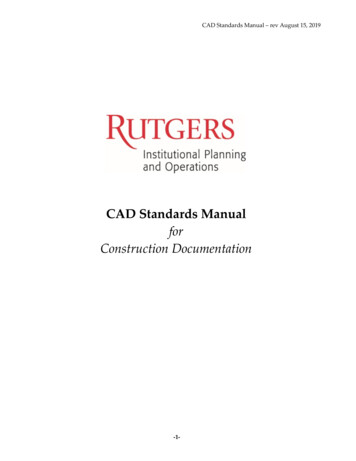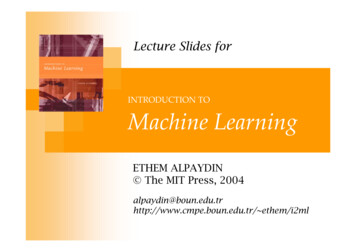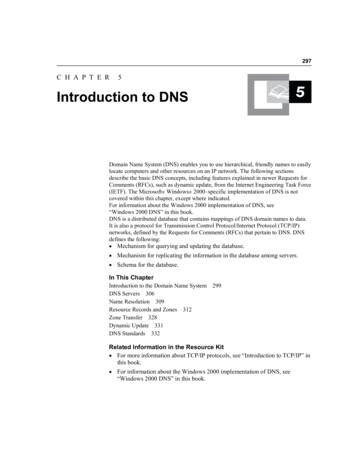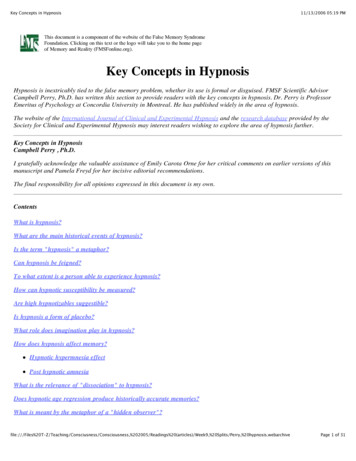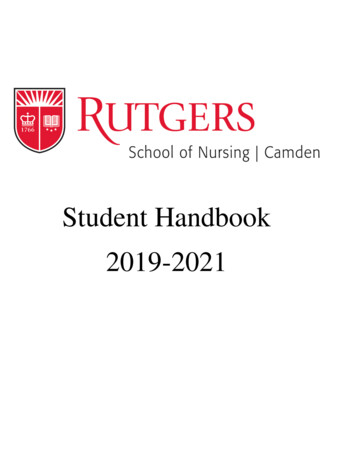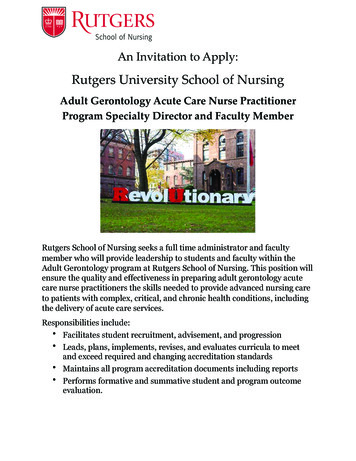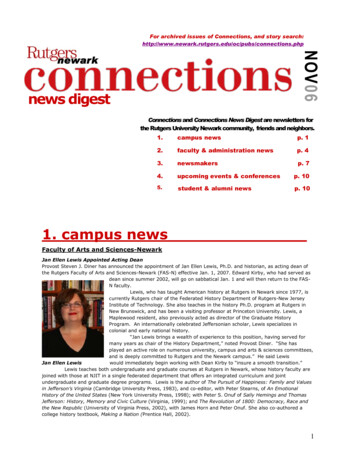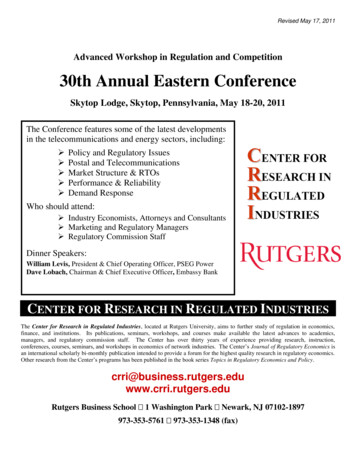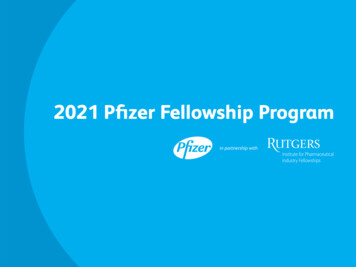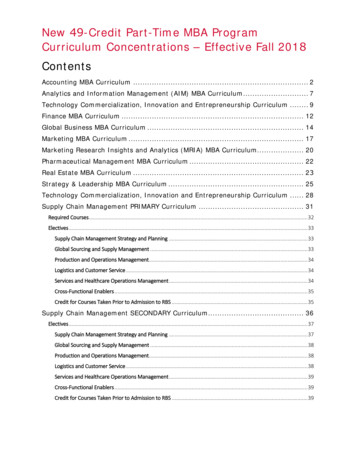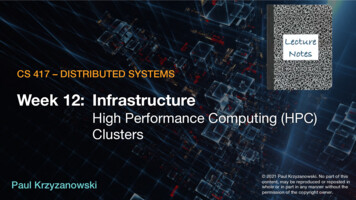
Transcription
CS 417 – DISTRIBUTED SYSTEMSWeek 12: InfrastructureHigh Performance Computing (HPC)ClustersPaul Krzyzanowski 2021 Paul Krzyzanowski. No part of thiscontent, may be reproduced or reposted inwhole or in part in any manner without thepermission of the copyright owner.
Supercomputers2021's most powerful supercomputer: Fugaku 富岳 – Japan – developed by RIKEN & Fujitsu Performance–– 442 petaflopsFujitsu A64FX SoC processors: 7.6 million ARM coresCommunication– Torus Fusion (tofu) – proprietary interconnect developed by Fujitsu OS– Compute nodes run McKernel (lightweight kernel designed forHPC) – a few hundred lines of C – Communicate with I/O nodes that run Linux 6-dimensional mesh/torus topology – full-duplex link with peakbandwidth of 5 GB/s in each directionStorage– 1.6 TB NVMe SSD for every 16 nodes– 150 PB shared storage – Lustre FSCost: US 1Bhttps://en.wikipedia.org/wiki/Fugaku (supercomputer)CS 417 2021 Paul Krzyzanowski2
Supercomputers2018’s Most powerful supercomputer:IBM AC922 – Summit at Oak Ridge National Laboratory 189 petaflops, 10PB memory 4,608 nodes 27,000 GPUs– 6 NVIDIA Volta V100s GPUs 9,000 CPUs––––2 IBM POWER9 CPUs512 GB DDR4 96GB HBM2 RAM1600GB NV memory42 teraflops per node 100G InfiniBand interconnect250 PB 2.5 TB/s file systemOS: Red Hat Enterprise LinuxPeak power consumption: 13 MWSee https://www.olcf.ornl.gov/summit/CS 417 2021 Paul Krzyzanowski3
Supercomputers are not distributed computers Lots of processors connected by high-speed networks Shared memory access Shared operating system (all TOP500 run Linux)CS 417 2021 Paul Krzyzanowski4
Supercomputing clusters Supercomputing cluster– Build a supercomputer from commodity computers & networks– A distributed system Target complex, typicallyscientific, applications:– Large amounts of data– Lots of computation– Parallelizable application Many custom efforts– Typically Linux message passing software remote exec remote monitoringCS 417 2021 Paul Krzyzanowski5
Cluster InterconnectsCS 417 2021 Paul Krzyzanowski6
Cluster InterconnectGoalsProvide communication between nodes in a clusterISPs– Low latency Avoid OS overhead, layers of protocols,retransmission, etc.switchswitch– High bandwidth High bandwidth, switched links Avoid overhead of sharing traffic with noncluster dataswitchswitchswitchRack 1Rack 2Rack N– Low CPU overhead– Low cost Cost usually matters if you’re connectingthousands of machines Usually a LAN is used:best /performance ratio40-80 computersClusterDatacenterCS 417 2021 Paul Krzyzanowski1,000s to 10,000 computers7
Cluster InterconnectAssume:10 Gbps per server40 servers per rack 400 Gbps/rack16 racks 8 TbpsClusterSwitchMax switch capacitycurrently 5 Tbps Need at least twocluster switchesCluster of 4 4 racksCS 417 2021 Paul Krzyzanowski8
Switches add latencyWithin one rack– One switch latency 1 8 μs for a 10 Gbps switch– Two links (to switch from switch) @ 1-2 meters of cable Propagation time in copper 2 108 m/s 5 ns/mBetween racks in a cluster– Three switch latency ( 3 24 μs)– 4 links (to rack switch to cluster switch back to target rack)– 10-100 meters distance (50 500 ns)Add to that the normal latency of sending & receiving packets:– System latency of processing the packet, OS mode switch, queuing the packet, copying data to thetransceiver, – Serialization delay time to copy packet to media 1 μs for a 1KB packet on a 10 Gbps linkCS 417 2021 Paul Krzyzanowski9
Dedicated cluster interconnectsTCP adds latency Operating system overhead, queueing, checksums, acknowledgements,congestion control, fragmentation & reassembly, Lots of interrupts Consumes time & CPU resourcesHow about using a high-speed LAN without the overhead? LAN dedicated for intra-cluster communication– Sometimes known as a System Area Network (SAN) Dedicated network for storage: Storage Area Network (SAN)CS 417 2021 Paul Krzyzanowski10
Example High-Speed InterconnectsCommon traits– TCP/IP Offload Engines (TOE)– TCP stack at the network card– Remote Direct Memory Access (RDMA)– memory copy with no CPU involvementIntel I/O Acceleration Technology (I/OAT) –combines TOE & RDMA–Data copy without CPU, TCP packet coalescing, lowlatency interrupts, CS 417 2021 Paul Krzyzanowski11
Example High-Speed InterconnectsExample: InfiniBandSwitch-based point-to-point bidirectional serial linksLink processors, I/O devices, and storageEach link has one device connected to itEnables data movement via remote direct memory access (RDMA) No CPU involvement!– Up to 250 Gbps/link–––– Links can be aggregated: up to 3000 Gbps with 12x linksIEEE 802.1 Data Center Bridging (DCB)– Set of standards that extend Ethernet– Lossless data center transport layer Priority-based flow control, congestion notification, bandwidth managementCS 417 2021 Paul Krzyzanowski12
Programming tools for HPC: PVMPVM Parallel Virtual Machine Software that emulates a general-purpose heterogeneous computingframework on interconnected computers Model: app set of tasks– Functional parallelism: tasks based on function: input, solve, output– Data parallelism: tasks are the same but work on different data PVM presents library interfaces to:––––Create tasksUse global task IDsManage groups of tasksPass basic messages between tasksCS 417 2021 Paul Krzyzanowski13
Programming tools: MPIMPI: Message Passing Interface API for sending/receiving messages– Optimizations for shared memory & NUMA– Group communication support Other features:––––Scalable file I/ODynamic process managementSynchronization (barriers)Combining resultsCS 417 2021 Paul Krzyzanowski14
HPC Cluster ExampleEarly example: Early ( 20 years old!) effort on Linux – Beowulf– Initially built to address problems associated with large data sets in Earthand Space Science applications– From Center of Excellence in Space Data & Information Sciences (CESDIS) Division of University Space Research Association at the Goddard Space FlightCenter– Still used!This isn’t one fixed package– Just an example of putting tools together to create a supercomputer fromcommodity hardwareCS 417 2021 Paul Krzyzanowski15
What makes it possible? Commodity off-the-shelf computers are cost effective Publicly available software:– Linux, GNU compilers & tools– MPI (message passing interface)– PVM (parallel virtual machine) Low cost, high speed networking Experience with parallel software– Difficult: solutions tend to be customCS 417 2021 Paul Krzyzanowski16
What can you run? Programs that do not require fine-grain communication Basic properties– Nodes are dedicated to the cluster Performance of nodes not subject to external factors– Interconnect network isolated from external network Network load is determined only by application– Global process ID provided Global signaling mechanismCS 417 2021 Paul Krzyzanowski17
HPC Cluster Examplehttp://openhpc.community 18 admin tools 3 compiler families (GNU, Intel, LLVM) 13 development tool packages (EasyBuild, cbuild, libtool, ) Lua scripting language & supporting packages 8 I/O libraries– Adios – enables defining how data is accessed– HDF5 – data model, library, and file format for storing and managing data– NetCDF – managing array-oriented scientific data Lustre file system 4 MPI packages 12 parallel libraries 14 performance tools Provisioning tools, resource management, runtime packages 6 threaded library packagesCS 417 2021 Paul Krzyzanowski18
HPC example: Rocks Cluster Distribution Employed on over 1,900 clusters n/view) Mass installation is a core part of the system– Mass re-installation for application-specific configurations Front-end central server compute & storage nodes Based on CentOS Linux Rolls: collection of packages– Base roll includes: PBS (portable batch system), PVM (parallel virtual machine), MPI (messagepassing interface), job launchers, Open-source Linux cluster distribution – supported by the National Science Foundation – rocksclusters.orgCS 417 2021 Paul Krzyzanowski21
Batch ProcessingCS 417 2021 Paul Krzyzanowski24
Batch processing Non-interactive processes– Schedule, run eventually, collect output Examples:– MapReduce, many supercomputing tasks(circuit simulation, climate simulation, weather)– Graphics rendering Maintain a queue of frames to be rendered Have a dispatcher to remotely exec process In many cases – minimal or no IPC needed Coordinator dispatches jobsCS 417 2021 Paul Krzyzanowski25
Single-queue work distribution: Render FarmsExample – Pixar:– 55,000 cores running RedHat Linux and Renderman (2018)– Custom Linux software for articulating, animating/lighting (Marionette), scheduling (Ringmaster),and rendering (RenderMan) Toy Story– Each frame took between 45 minutes to 30 hours to render: 114,240 total frames– 117 computers running 24 hours a day– Toy Story 4 – 24 years later: 50-150 hours to render each frame Took over two years (in real time) to render Monsters University (2013)– Sully has over 1 million hairs – each rendered distinctly & motion animated Average time to render a single frame– Cars (2006): 8 hours– Cars 2 (2011): 11.5 hours– Disney/Pixar’s Coco – Up to 100 hours to render one frameCS 417 2021 Paul Krzyzanowski26
Batch Processing OpenPBS.org:– Portable Batch System– Developed by Veridian MRJ for NASA Commands– Submit job scripts Submit interactive jobs Force a job to run– List jobs– Delete jobs– Hold jobsCS 417 2021 Paul Krzyzanowski28
Load BalancingCS 417 2021 Paul Krzyzanowski29
Functions of a load balancer Load balancing Failover Planned outage managementCS 417 2021 Paul Krzyzanowski30
RedirectionSimplest techniqueHTTP REDIRECT error codeCS 417 2021 Paul Krzyzanowski31
RedirectionSimplest techniqueHTTP REDIRECT error codewww.mysite.comCS 417 2021 Paul Krzyzanowski32
RedirectionSimplest techniqueHTTP REDIRECT error codewww.mysite.comREDIRECTwww03.mysite.comCS 417 2021 Paul Krzyzanowski33
RedirectionSimplest techniqueHTTP REDIRECT error codewww03.mysite.comCS 417 2021 Paul Krzyzanowski34
Redirection Trivial to implement Successive requests automatically go to the same web server– Important for sessions Visible to customer– Don’t like the changing URL Bookmarks will usually tag a specific siteCS 417 2021 Paul Krzyzanowski35
Load balancing router As routers got smarter– Not just simple packet forwarding– Most support packet filtering– Add load balancing to the mix– This includes most IOS-based Cisco routers, Radware Alteon, F5 Big-IPCS 417 2021 Paul Krzyzanowski36
Load balancing router Assign one or more virtual addresses to physical address– Incoming request gets mapped to physical address Special assignments can be made per port– e.g., all FTP traffic goes to one machine Balancing decisions:––––Pick machine with least # TCP connectionsFactor in weights when selecting machinesPick machines round-robinPick fastest connecting machine (SYN/ACK time) Persistence– Send all requests from one user session to the same systemCS 417 2021 Paul Krzyzanowski37
DNS-based load balancing Round-Robin DNS– Respond to DNS requests with different addresses or a list of addresses instead of one addressbut the order of the list is permuted with each response Geographic-based DNS response––––Multiple clusters distributed around the worldBalance requests among clustersFavor geographic proximityExamples: BIND with GeoDNS patch PowerDNS with Geo backend Amazon Route 53CS 417 2021 Paul Krzyzanowski39
The EndCS 417 2021 Paul Krzyzanowski40
Supercomputing cluster – Build a supercomputer from commodity computers & networks . Rocks Cluster Distribution Employed on over 1,900 clusters (https: . Open-source Linux cluster distribution – supporte

